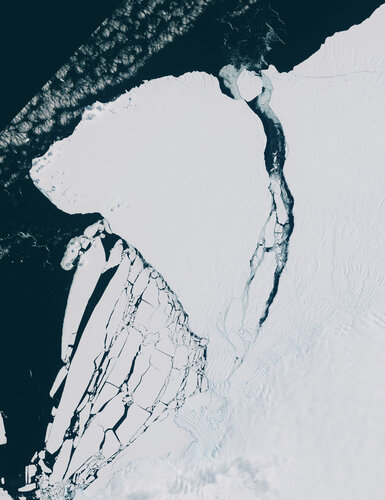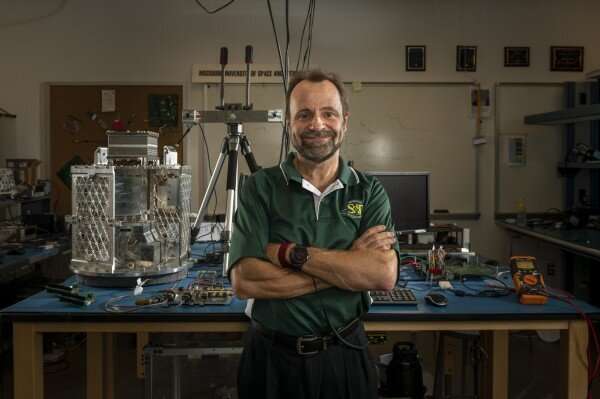
Copernical Team
ESA’s digital Historical Archives open online

We’re marking 20 years of the European Centre for Space Records in ESA ESRIN, Frascati, one of the physical homes of the ESA Archives, by giving access to our digital holdings in a new web portal.
Giant iceberg breaks away from Antarctic ice shelf

Satellite imagery confirms an enormous iceberg, around five times the size of Malta, has finally calved from Antarctica’s Brunt Ice Shelf. The new berg, estimated to be around 1550 sq km and around 150 m thick, calved when the crack known as Chasm-1 fully extended northwards severing the west part of the ice shelf.
This crack was first revealed to be extending in early 2012 after having been dormant for some decades. After several years of desperately clinging on, image data from the Copernicus Sentinel missions visually confirm the calving event.
Printed nerves for a satellite
 Image:
Printed nerves for a satellite
Image:
Printed nerves for a satellite Rocket Lab launches first Electron mission from US
 Rocket Lab USA, Inc. has launched its 33rd Electron rocket and first mission from Virginia. The "Virginia is for Launch Lovers" mission lifted off at 18:00 EST on January 24th from Rocket Lab Launch Complex 2 (LC-2) at Virginia Space's Mid-Atlantic Regional Spaceport within NASA's Wallops Flight Facility. The mission deployed three satellites to a 550km orbit for leading radio frequency geospati
Rocket Lab USA, Inc. has launched its 33rd Electron rocket and first mission from Virginia. The "Virginia is for Launch Lovers" mission lifted off at 18:00 EST on January 24th from Rocket Lab Launch Complex 2 (LC-2) at Virginia Space's Mid-Atlantic Regional Spaceport within NASA's Wallops Flight Facility. The mission deployed three satellites to a 550km orbit for leading radio frequency geospati Astronomers confirm age of most distant galaxy with oxygen
 A new study led by a joint team at Nagoya University and the National Astronomical Observatory of Japan has measured the cosmic age of a very distant galaxy. The team used the ALMA radio telescope array to detect a radio signal that has been travelling for approximately 97% of the age of the Universe. This discovery confirms the existence of galaxies in the very early Universe found by the James
A new study led by a joint team at Nagoya University and the National Astronomical Observatory of Japan has measured the cosmic age of a very distant galaxy. The team used the ALMA radio telescope array to detect a radio signal that has been travelling for approximately 97% of the age of the Universe. This discovery confirms the existence of galaxies in the very early Universe found by the James Rocket Lab launches first Electron mission from US soil
 Rocket Lab USA, Inc. has launched its 33rd Electron rocket and first mission from Virginia. The "Virginia is for Launch Lovers" mission lifted off at 18:00 EST on January 24th from Rocket Lab Launch Complex 2 (LC-2) at Virginia Space's Mid-Atlantic Regional Spaceport within NASA's Wallops Flight Facility. The mission deployed three satellites to a 550km orbit for leading radio frequency geospati
Rocket Lab USA, Inc. has launched its 33rd Electron rocket and first mission from Virginia. The "Virginia is for Launch Lovers" mission lifted off at 18:00 EST on January 24th from Rocket Lab Launch Complex 2 (LC-2) at Virginia Space's Mid-Atlantic Regional Spaceport within NASA's Wallops Flight Facility. The mission deployed three satellites to a 550km orbit for leading radio frequency geospati Spacecraft design expert discusses the viability of interstellar travel

Researchers at NASA recently announced the discovery of another planet about 95% the size of Earth that is 100 light-years away and could potentially sustain life.
Could this new discovery lead to humans one day traveling to planet TOI 700 e and enjoying its resources, such as the potential for liquid water? This is a question people may naturally ask, but they may not like the current answer.
"That is not going to happen in our lifetimes, but it is fascinating to discuss," says Dr.
Were galaxies much different in the early universe?
 An array of 350 radio telescopes in the Karoo desert of South Africa is getting closer to detecting "cosmic dawn" - the era after the Big Bang when stars first ignited and galaxies began to bloom.
In a paper accepted for publication in The Astrophysical Journal, the Hydrogen Epoch of Reionization Array (HERA) team reports that it has doubled the sensitivity of the array, which was already
An array of 350 radio telescopes in the Karoo desert of South Africa is getting closer to detecting "cosmic dawn" - the era after the Big Bang when stars first ignited and galaxies began to bloom.
In a paper accepted for publication in The Astrophysical Journal, the Hydrogen Epoch of Reionization Array (HERA) team reports that it has doubled the sensitivity of the array, which was already How a 3 cm glass sphere could help scientists understand space weather
 Solar flares and other types of space weather can wreak havoc with spaceflight and with telecommunications and other types of satellites orbiting the Earth. But, to date, scientists' ability to research ways to overcome that challenge has been severely limited. That's because experiments they conduct in laboratories here on Earth are affected by gravity in ways that are so different from conditi
Solar flares and other types of space weather can wreak havoc with spaceflight and with telecommunications and other types of satellites orbiting the Earth. But, to date, scientists' ability to research ways to overcome that challenge has been severely limited. That's because experiments they conduct in laboratories here on Earth are affected by gravity in ways that are so different from conditi Webb Telescope identifies origins of icy building blocks of life
 Frozen molecules were central to the origin of life on Earth. In addition to impacts of icy comets and asteroids, according to current theory, our planet likely also received the elementary components of life from the ices of the immense interstellar molecular cloud from which the Earth and the rest of the solar system emerged.
In a new study, an international research team, with the parti
Frozen molecules were central to the origin of life on Earth. In addition to impacts of icy comets and asteroids, according to current theory, our planet likely also received the elementary components of life from the ices of the immense interstellar molecular cloud from which the Earth and the rest of the solar system emerged.
In a new study, an international research team, with the parti 
